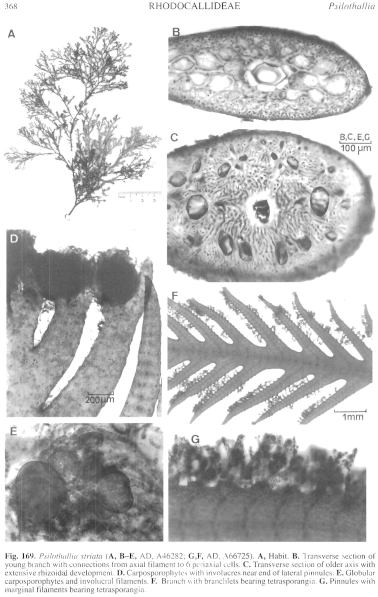|
|
|
|
|
|||||||||||
|
Electronic Flora of South Australia Species Fact Sheet
Phylum Rhodophyta – Order Ceramiales – Family Ceramiaceae – Tribe Rhodocallideae
Selected citations: De Toni 1903: 1390. Huisman & Walker 1990: 424. Kylin 1956: 394. Lucas 1909: 51. Lucas & Perrin 1947: 346, fig. 172. May 1965: 375. Mazza 1911: No. 401. Schmitz & Hauptfleisch 1897: 496. Silva et al. 1996: 421.
Synonyms
Ptilota striata Harvey 1855a: 558; 1859a; pl. 71; 1863, synop.: xl ix. J. Agardh 1876: 80. Sonder 1881: 11.
Plumaria striata (Harvey) Kuntze 1891: 911.
Thallus (Fig. 169A) erect, dark red-brown, 10–18 cm high, pinnate, much branched complanately with indeterminate branches bearing alternate, distichous, close set, terete, determinate branchlets (Fig. 169F) 1.5–2.5 mm long, upper branches 0.4–1 mm broad, compressed, near the base 1–1.5 mm in diameter, terete and denuded; branches horizontally striate (Fig. 169F) corresponding to the axial cells. Holdfast conical, 2–4 mm across; epilithic. Structure. Apical filaments soon overtopped by periaxial filaments from below, axial cells increasing to 90–140 µm in diameter and L/D 1.5–2.5, cutting off (close to the apex) opposite periaxial filaments in the plane of branching of which alternate ones 2 (–3) axial cells apart develop into determinate branchlets, and 2–4 transverse periaxial cells (Fig. 169B) which produce whorls of 6–10 periaxial filaments which remain compact and form the more or less terete central part of the branches; in tetrasporangial plants these filaments extend through the cortex but become denuded, with whorls of only the larger basal cells visible in the cortex surface. The central part of branches becomes swollen by extensive rhizoid development (Fig. 169C) around the axial and inner cells, separating these cells from each other; surface cells of the cortex are small, compact, isodiametric, 2–3 µm across. Cells probably uninucleate; rhodoplasts discoid.
Reproduction: Carpogonial branches unknown. Carposporophytes (Fig. 169D, E) formed in dense, globular tufts of simple filaments 250–350 µm long and 10–14 µm in diameter, with cells L/D 0.8–1.4; gonimolobes rounded, 90–140 µm across, carposporangia ovoid, 10–15 µm in diameter. Spermatangia unknown.
Tetrasporangia on clustered, branched filaments (Fig. 169F, G) derived from the periaxial filaments on the adaxial (and abaxial) sides of determinate branchlets and external to the cortex, filaments 10–15 µm in diameter, cells L/D 1–1.3, tetrasporangia slightly ovoid, 20–25 µm in diameter, tetrahedrally divided.
Type from Rottnest I., W. Aust. (Harvey); lectotype Tray. Set 240, Herb. Harvey, TCD.
Selected specimens: Fremantle, W. Aust. (Harvey, AIg. Aust. Exsicc. 477A; MEL, 26396). Point Peron, W. Aust., drift (Royce 486, 28.i.1950; AD, A15500). 11 km off Cape Northumberland, S. Aust., 48 m deep (Shepherd, 6.v.1975; AD, A46282).
Distribution: Fremantle, W. Aust., to Cape Northumberland, S. Australia.
Taxonomic notes: Details of the apical development and reproduction of this rare species await detailed study.
References:
AGARDH, J.G. (1876). Species Genera et Ordines Algarum. Vol. 3, Part 1- Epicrisis systematic Floridearum, pp. i-vii, 1–724. (Weigel: Leipzig.)
DE TONI, G.B. (1903). Sylloge Algarum omnium hucusque Cognitarum. Vol. 4. Florideae. Sect. 3, pp. 775–1521 + 1523–1525. (Padua.)
HARVEY, W.H. (1855a). Some account of the marine botany of the colony of Western Australia. Trans. R. Jr. Acad. 22, 525–566.
HARVEY, W.H. (1859a). Phycologia Australica. Vol. 2, Plates 61–120. (Reeve: London.)
HARVEY, W.H. (1863). Phycologia Australica. Vol. 5, Plates 241–300, synop., pp. i-lxxiii. (Reeve: London.)
HUISMAN, J.M. & WALKER, D.I. (1990). A catalogue of the marine plants of Rottnest Island, Western Australia, with notes on their distribution and biogeography. Kingia 1, 349–459.
KUNTZE, O. (1891). Revisio generum Plantarum. Part II. 4. Algae, pp. 877–930. (Leipzig.)
KYLIN, H. (1956). Die Gattungen der Rhodophyceen. (Gleerups: Lund.)
LUCAS, A.H.S. & PERRIN, F. (1947). The Seaweeds of South Australia. Part 2. The Red Seaweeds. (Govt Printer: Adelaide.)
LUCAS, A.H.S. (1909). Revised list of the Fucoideae and Florideae of Australia. Proc. Linn. Soc. N.S.W. 34, 9–60.
MAY, V. (1965). A census and key to the species of Rhodophyceae (red algae) recorded from Australia. Contr. N.S.W. natn. Herb. 3, 349–429.
MAZZA, A. (1911). Saggio di Algologia Oceanica. Nuova Notarisia 22, Nos. 369–393.
SCHMITZ, F. & HAUPTFLEISCH, P. (1897). Ceramiaceae. In Engler, A. & Prantl, K., Die natarlichen Pflanzenfamilien, Vol. 1, Part 2, pp. 481–504. (Leipzig.)
SCHMITZ, F. (1896). Kleinere beitrage zur kenntniss der Florideen. Nuova Notarisia, Padova 7, 1–22.
SILVA, P.C., BASSON, P.W. & MOE, R.L. (1996). Catalogue of the Benthic Marine Algae of the Indian Ocean. (University of California Press: Berkeley, Los Angeles & London.)
SONDER, O.W. (1881). In Mueller, F., Fragmenta Phytographiae Australiae. Supplementum ad volumen undecinum: Algae Australianae hactenus cognitae, pp. 1–42, 105–107. (Melbourne.)
The Marine Benthic Flora of Southern Australia Part IIIC complete list of references.
Publication:
Womersley, H.B.S. (24 December, 1998)
The Marine Benthic Flora of Southern Australia
Rhodophyta. Part IIIC. Ceramiales – Ceramiaceae, Dasyaceae
©State Herbarium of South Australia, Government of South Australia
Illustration in Womersley Part IIIA, 1998: FIG. 169.

Figure 169 enlarge
Fig. 169. Psilothallia striata (A, B–E, AD, A46282; G,F, AD, A66725). A, Habit. B. Transverse section of young branch with connections from axial filament to 6 periaxial cells. C. Transverse section of older axis with extensive rhizoidal development. D. Carposporophytes with involucres near end of lateral pinnules. E. Globular carposporophytes and involucral filaments. F. Branch with branchlets bearing tetrasporangia. G. Pinnules with marginal filaments bearing tetrasporangia.

|
Email Contact: State Herbarium of South Australia |

|